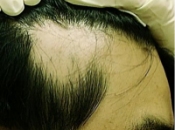Alopecia areata is commonly seen in children and young adults. 10 to 20% has a family history.
Cause
This is related to a disorder of the immune system, which somehow does not recognise the hair follicles as self and attack them as if they are foreign. Among the sufferers, many have other auto-immune problems as well. 4 % of them has vitiligo, and up to 25% of children have abnormal thyroid functions or antibody against the thyroid.
Signs
The area of hair loss is not itchy or tender. There is usually no feeling. The person suffering from it may notice this only when they touch a smooth round patch of skin on the scalp by chance, or when they are told the presence of this by the hairdresser.
There are one or more round areas, which are smooth and not inflamed. The sizes may range from less than 1 cm to more than 10 cm across. At the margins, the hair may appear thinner at the bottom end and looks like an inverted exclamation mark.

When new hair grows back in that area, they are fine, fragile, lack of lustre, and may appear white. They are slowly replaced with normal hair. There is no scar after recovery.
Although alopecia areata affects mainly the scalp hair, but 10% can happen outside the scalp, such as the eyebrows, eyelashes, and mustaches. Few people may progress to the whole scalp (Alopecia Totalis), and even fewer people may progress to affect the hair on the whole body (Alopecia Universalis).
10 to 20 % of sufferers have tiny indentations on the surface of the nails (nail pittings), which are usually arranged in vertical or horizontal lines.
The diagnosis is easy and does not require any investigations. Tests may be done for the thyroid functions, particularly in children, as the chance of abnormalities is as high as 25%.
Progress
This is difficult to estimate. Most will recover on their own. In general, the younger the age of onset, and the larger the affected area, it is more unlikely to recover. For the very large sizes; hair outside the scalp; alopecia totalis, or alopecia universalis, the chance of recovery is much smaller.
In the first attack, most people will recover in 1 to 2 years : 30% in the first 6 months; and 50% in the first year. However, some people may never have the hair grown back, and for those who have recovered, 50% will have a new attack at a new place.
Treatments
Steroid
Small areas can be treated with injection of steroid. Usually there is new hair coming out 4 to 6 weeks after the injection, and it can be repeated after 1 month if necessary. It is more effective to use an injection gun designed to inject substances into the dermis by vacuum pressure. The pain is less and the accuracy of injecting into the dermis is higher.
 |
 |
 |
|
Before |
Immediately After |
1 month Later |
If there is no response after 3 months, then it may not be necessary to continue. It can be repeated again if the condition recurs. For those ones that have persisted for a long time without recovery, the chance of success is very low.
Minoxidil Lotion
It is applied twice daily on the affected area. Evidences of its effectiveness in the clinical studies are not consistent and vary a great deal. It is usually regarded as a supplementary treatment in addition to steroid injection.
Mesotherapy
The concept of mesotherapy is to inject directly a small quantity of some ingredients into the dermis of the skin, to exert a positive treatment result in and around that area. This method has been and is still very popular in Europe, in various branches of Medicine.
Mesotherapy is now used in treating cellulites, tightening lax skin, rejuvenating aging skin, treating scars and hair loss.
The doctor will mix a cocktail of different ingredients, including vitamin B5, vitamin H (Biotin), which are essential in hair growth and will increase the blood circulation in the scalp. In some cases, minoxidl can be added as well. It may have unexpected result in some resistant cases.
The depth of injection is only 3 to 4mm. The pain is tolerable. Usually a course of treatment consists of a weekly treatment for 3 to 4 weeks, and then a bi-weekly treatment for another 3 to 4 weeks.
Others
Treatments used in the past include phototherapy, and local irritants such as Dinitrochlorobenzene and Dithrano. The results were not encouranging.

